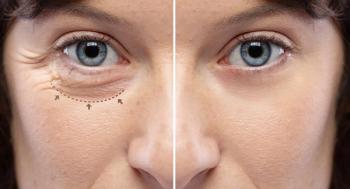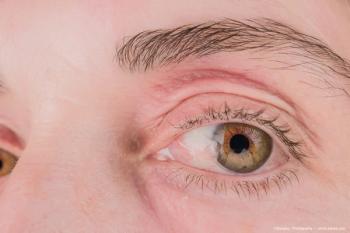
Glaucoma risk may increase after cataract removal in early infancy
Glaucoma is more likely to develop in children who undergo cataract surgery when they are 6 weeks or younger.
Reviewed by Scott R. Lambert, MD
Atlanta-Consider this case scenario: A 6-week-old infant undergoes bilateral lensectomy. The child is fitted with contact lenses after surgery. Two months postoperatively, the mother reports the baby’s right cornea is hazy, and the child seems to prefer the left eye. IOP is 24 and 18 mm Hg in the right and left eyes, respectively.
“This patient is the typical child in whom glaucoma develops after cataract surgery,” said Scott R. Lambert, MD.
“It has been reported that 15% to 30% of these children who undergo cataract extraction during infancy will develop glaucoma,” said Dr. Lambert, professor of ophthalmology, Emory University, Atlanta. “Glaucoma rarely develops in children who undergo cataract surgery after more than 6 months of age.”
Sponsored:
Following this populace throughout childhood may shed some light on factors involved in glaucoma development, and if IOL implantation has any protective effect against glaucoma, he noted.
There are a few theories behind the development of glaucoma in early infancy, one being that the immature angle collapses. Another is there is a disturbance in the maturation of the trabecular meshwork.
More:
However, the actual cause remains unclear, Dr. Lambert said.
There are a number of risk factors for glaucoma after cataract extraction in children: surgery performed at a young age, persistent fetal vasculature (PFV), microphthalmos, repeated surgeries, retained lens material, and chronic inflammation.
Implantation of an IOL is one factor thought to be protective against glaucoma development in this patient population. However, this theory has arisen out of retrospective studies with selection bias and other confounding variables.
Related:
“It is not really clear if IOL implantation is a protective factor,” he said.
Evaluating IOL effectiveness
In 2004, Dr. Lambert and colleagues started a prospective, randomized trial, the Infant Aphakia Treatment Study, to evaluate how effective IOLs are for treating children who were to undergo unilateral cataract surgery.
The recently published study (Friedman et al. JAMA Ophthalmol. 2015;33:907-914) included 114 infants who ranged in age from 1 to 6 months. The children were randomly assigned to a unilateral cataract surgery with or without implantation of an IOL. When the children reached age 5, they underwent tonometry, pachymetry, and an optic disc evaluation to determine the presence of glaucoma.
More:
The National Eye Institute provided funding to cover examinations of these children when they reach age 10. That examination will include more extensive glaucoma evaluations including, tonometry, anterior segment optical coherence tomography, analysis of the retinal nerve fiber layer, and photography of the optic disc.
To date, 24 children have reached their 10th birthdays and undergone the evaluation. The other 90 also will be evaluated over the next 2.5 years.
Outcomes at 5 years indicated the incidence of glaucoma was higher in patients who had cataract surgery at a younger age. The authors divided the children into those who were 28 to 48 days old and those who were 49 to 210 days old.
Recent news:
Risk of glaucoma development
The probability of glaucoma was 16% in the younger group compared with 3% in the older group. By age 5, the probability increased to 26% in the younger group compared with 9% in the older group. This difference was highly statistically significant (p = 0.014), Dr. Lambert said.
There was more than a three-fold greater risk of developing glaucoma if surgery is performed when the children are 6 weeks of age or younger, he noted.
Investigators found that in the 24 eyes with PFV, glaucoma developed in 29% compared with 13% in the 90 children who did not have PFV. This difference, however, did not reach significance (p = 0.083).
More:
Regarding development of glaucoma, the cumulative probability indicated that most cases develop early, within 6 months after cataract surgery, or when the children were between 3 and 5 years old. Analysis of glaucoma or glaucoma suspects differed in that the incidence of glaucoma was more gradual and increased to development in 31% of children by age 5.
A comparison of the children who received an IOL implant after cataract surgery, and those who did not, showed glaucoma incidence was higher in children with an IOL throughout the 5 years after cataract surgery, but the difference was not significant (p = 0.62).
When investigators compared the two treatment groups for the cumulative probability of glaucoma or glaucoma suspects at 5 years of age, they found that early after surgery the patients who received the IOL had developed glaucoma or were glaucoma suspects.
However, by age 4.5 the scenario switched because a number of the aphakic children became suspects and by age 5 years, more children in the aphakic group than the IOL had glaucoma or were glaucoma suspects, Dr. Lambert explained.
Related:
“This switching of scenarios is why these children will be followed to age 10 to determine if the trend continues in the aphakic group,” he explained.
Recent:
The important points from this study were that the risk of development of glaucoma increases by three-fold when cataracts are removed when patients are 6 weeks or younger; 4.8 years after cataract surgery, the risk of glaucoma is 17% and the risk of glaucoma or glaucoma suspects is 31%.
Follow-up examination at 10 years of age will determine if primary IOL implantation reduces the risk of glaucoma.
More:
Scott R. Lambert, MD
This article was adapted from Dr. Lambert’s presentation at Glaucoma Subspecialty Day during the 2015 meeting of the American Academy of Ophthalmology. Dr. Lambert received a grant from the National Eye Institute.
Newsletter
Don’t miss out—get Ophthalmology Times updates on the latest clinical advancements and expert interviews, straight to your inbox.













































.png)


